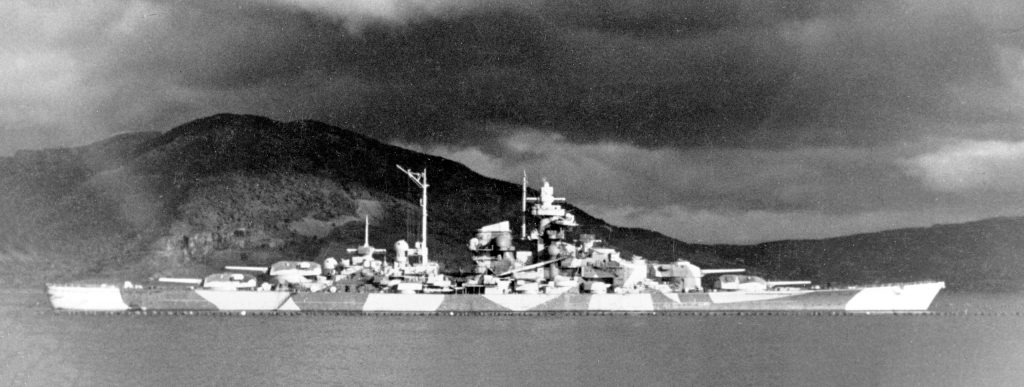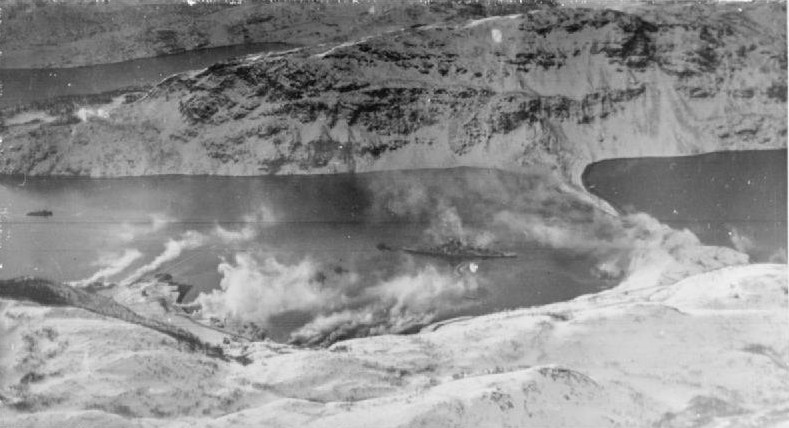Operation Tungsten, conducted on April 3, 1944, was a meticulously planned British naval air strike targeting the German battleship Tirpitz anchored in Norway’s Kaafjord.
Using a combination of Barracuda bombers and fighter escorts, the operation inflicted significant damage on the Tirpitz, sidelining it for months and alleviating the threat it posed to the Arctic convoys.
This successful raid highlighted the potency of coordinated naval aviation and marked a pivotal moment in the Allies’ efforts against German naval assets during World War II.
Planning Operation Tungsten
The German battleship Tirpitz was not just a symbol of the Kriegsmarine’s might, but also a tangible and looming threat to the Allied naval operations, particularly the Arctic convoys that were pivotal in supplying the Soviet Union.
Its strategic positioning in Norwegian waters gave it the ability to quickly intercept and challenge any Allied naval movement in the North Atlantic and Arctic regions. This potential threat meant the Allies had to constantly maintain a sizable naval presence in the vicinity, tying up resources that could have been deployed elsewhere.
Given the high strategic value of neutralizing the Tirpitz, multiple operations were conceived and executed before Operation Tungsten.
The use of Chariot human torpedoes and midget submarines in Operation Source, for instance, was an audacious attempt that demonstrated the lengths to which the British were willing to go.
While these efforts did inflict damage, they did not achieve the ultimate goal: the permanent incapacitation or destruction of the Tirpitz.
 The Tirpitz in a Norwegian Fjord.
The Tirpitz in a Norwegian Fjord.
By the onset of 1944, the necessity to address the “Fleet in Being” phenomenon—where the mere presence of the Tirpitz compelled disproportionate Allied countermeasures—became even more pressing. With the invasion of Normandy (D-Day) on the horizon, Allied command recognized the need to consolidate naval forces and ensure that threats like the Tirpitz were adequately addressed.
In response, Operation Tungsten was meticulously planned. The central idea was to use aerial power to strike the Tirpitz, leveraging the element of surprise and precision that such an attack could offer.
The British Royal Navy assembled a formidable force of aircraft, with the Barracuda torpedo bombers playing the starring role.
These aircraft were selected for their ability to deliver heavy payloads and for their resilience against anti-aircraft fire.
Furthermore, recognizing the dense anti-aircraft defenses that would surround the Tirpitz, planners also incorporated a significant number of fighters like the Corsair, Hellcat, and Wildcat.
These fighters had dual roles: to protect the Barracudas from any potential German fighter interceptions and to suppress the anti-aircraft fire from the Tirpitz and surrounding defenses.
The Attack On The Tirpitz
On the morning of April 3, 1944, the fjords of Norway bore witness to a large formation of British aircraft, spearheaded by the formidable Barracuda torpedo bombers, preparing to challenge the German behemoth.
The Arctic setting, with its notoriously unpredictable weather and vast expanses, added a layer of complexity to the mission, making the feat all the more impressive.
The First Wave: The initial assault on the Tirpitz consisted of 21 Barracudas escorted by 40 fighters. This formation was by no means random. The role of the first wave was multifaceted.
First, it aimed to breach the smoke screen—a defensive measure employed by the Germans, where smoke generators created a thick, concealing veil around the Tirpitz to obstruct visibility and thwart aerial targeting.
By navigating through or above this smoke screen, the first wave was tasked with identifying optimal drop points for their payloads.
Simultaneously, this wave had a critical role in suppressing and, if possible, neutralizing the Tirpitz’s anti-aircraft capabilities.
The sheer volume of flak—exploding anti-aircraft fire—was expected to be intense, given the battleship’s extensive defensive arsenal.
The fighters accompanying the Barracudas would engage these anti-aircraft positions, ensuring that the bombers could approach their target with a reduced threat level.
 The Tirpitz at Kaafjord during Operation Tungsten. A smoke screen has been deployed, partially covering the battleship.
The Tirpitz at Kaafjord during Operation Tungsten. A smoke screen has been deployed, partially covering the battleship.
The Second Wave: Close on the heels of the first wave was the second formation, comprising 19 Barracudas and an accompanying escort of 40 fighters. This wave’s primary objective was to capitalize on any disruption caused by the preceding wave.
With the anti-aircraft defenses hopefully suppressed and the smoke screen penetrated, the second wave’s bombers would have a clearer path to deliver their deadly payloads onto the Tirpitz.

The coordination between the two waves was paramount. The time gap between them had to be narrow enough to prevent the German defenses from regrouping, but also sufficient to avoid any friendly fire incidents or mid-air collisions.
Throughout the raid, the accompanying fighters—Corsair, Hellcat, and Wildcat—played a pivotal role. While the Barracudas were armed and designed for bombing, these fighters were agile, equipped for dogfights, and tasked with ensuring that no German aircraft could intercept the bombers.
Furthermore, they continually harassed and targeted the anti-aircraft defenses on and around the Tirpitz.
 Hellcat fighter planes on the deck of HMS Emperor prior to the attack.
Hellcat fighter planes on the deck of HMS Emperor prior to the attack.
As the dust settled, the efficacy of the attack became evident. Despite the formidable defenses and challenging environment, the Barracudas managed to achieve multiple direct hits on the Tirpitz.
The combination of precision bombing, effective fighter cover, and synchronized wave attacks rendered the battleship significantly damaged, proving the effectiveness of the tactics employed during Operation Tungsten.
Impact Of Operation Tungsten
Operation Tungsten inflicted substantial damage on the Tirpitz, marking one of the most successful direct assaults on the vessel. While the ship did not sink, the barrage of bombs from the Barracudas compromised its operational capabilities.
Notably, the armored deck of the Tirpitz sustained damage, and some of its primary turrets were rendered non-functional.
These physical damages necessitated extensive repairs, which took months to complete, sidelining the battleship from any immediate naval operations.
Furthermore, the human cost to the German Kriegsmarine was considerable. 122 crew members lost their lives during the attack, with many more injured. The loss of trained personnel and the blow to morale were outcomes that statistics alone could not capture.
 Bombs from the Barracudas explode on the Tirpitz during the wave of Operation Tungsten.
Bombs from the Barracudas explode on the Tirpitz during the wave of Operation Tungsten.
With the Tirpitz effectively sidelined post-Tungsten, the Allies gained a strategic breathing space in the North Atlantic and Arctic regions.
The threat that the Tirpitz posed was not just in its firepower but in its ability to disrupt Allied naval movements, particularly the crucial Arctic convoys.
With the battleship incapacitated, these convoys faced reduced risks, ensuring that supplies could reach the Soviet Union more safely.
Additionally, the success of Operation Tungsten boosted the morale of the Allied forces. The Tirpitz, much like its sister ship Bismarck, held symbolic value.
Demonstrating the capability to strike such a potent symbol of German naval power resonated throughout the Allied ranks, reinforcing the belief in their cause and abilities.
Tungsten’s success was not an isolated event. It paved the way for further operations targeting the Tirpitz. Operations Mascot, Goodwood, and Paravane were subsequent attempts to neutralize the battleship completely.
While these operations had varying degrees of success, they culminated in Operation Catechism, where the RAF finally sank the Tirpitz using Tallboy bombs.
Operation Tungsten underscored the potential of naval aviation as a tool of strategic warfare. The operation showcased the effectiveness of combining torpedo bombers with fighter escorts, laying down tactics that would be studied and emulated in subsequent naval conflicts.





